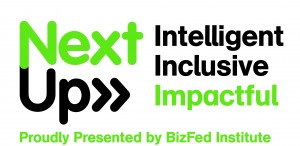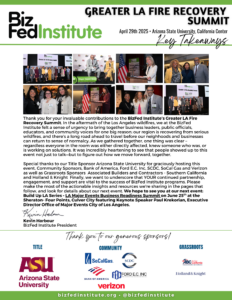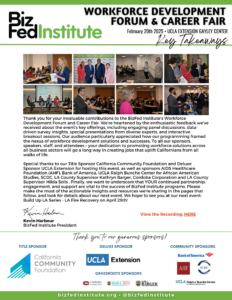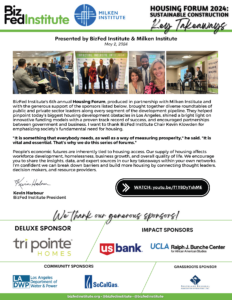
Pop! Bursting the California Water Bubble Intel Report
East Los Angeles College – Thursday, November 16, 2017
Thank you to our generous sponsors: The Metropolitan Water District of Southern California, Cordoba Corporation, Torrance Refining Company, Southern California Water Committee, and Randy Witt Productions.
View the BizFed Institute (BFI)Â NextUp Economic Forum: Pop! Bursting the California Water Bubble in its entirety online via YouTube. Please click any of the following links for the segment you wish to view or view full playlist here:
To view Speakers’ full bios, click here.
Introduction
In the first installment of a multi-part series on exploring the impacts of California’s evolving population on vital resources and the economy in California, the BizFed Institute (BFI) NextUp Economic Forum’s Pop! Bursting the California Water Bubble sought to discuss the interconnection between population and water supply, implications of water-use patterns, the state of our current water system, and prioritized solutions to work towards sustainable water availability and reliability for the myriad of business and community needs. We can’t forget that it was only one year ago when California went from years of extreme drought to record rainfall. California made it through a historical drought by conserving and utilizing the investments that were in place, but when we’re faced with a growing and changing population, aging infrastructure, and limited resources, it’s imperative to burst the bubble of usual post-drought complacency and reactive measures to plan ahead and actively prioritize solutions.
Our thought leaders and experts featured at the NextUp forum shined a light on the realities and various perspectives in addressing water issues. The business community will need to determine whether their role in all this can be better enhanced to protect their bottom line while being actively a part of the larger conversation of staying ahead of the curve to ensure that all stakeholders will have access to the essentials like water and the capacity to thrive.
39.5 Million & Counting on H2O
Speakers:
Ronald Gastelum, President, Water Conservation Partners (Moderator)
Caitrin Phillips Chappelle, Associate Director of Water Policy Center, Public Policy Institute of California (Presenter)
Bruce Reznik, Executive Director, Los Angeles Waterkeeper
Deven Upadhyay, Assistant General Manger/COO, Metropolitan Water District of Southern California
Summary:
Early on during the segment’s presentation on population data and the story of California’s water by the numbers, Caitrin Phillips Chappelle affirmed that population is one of the biggest drivers of change for California water issues. The reality of population growth heading towards 50 million by 2050 paired with other sobering changes, including hotter droughts, floods, and the dwindling snowpack, along with successes like getting more for each drop in urban areas and agriculture, underscores the need to evaluate our existing systems, water-use trends, and strategies on next investments.
The first myth-busting type of revelation Caitrin made was that California is a water rich state, but there’s lack of alignment between where water falls and where there’s the most demand. Even with impactful investments to move water currently, grappling with water issues in context with population growth is less about having enough water and more about being better at planning for water use by factoring in efficiency, multiple uses, and other ways on how we can use existing water in different ways. She presented an “all of the above†approach, which encompasses supply diversification, regulatory and policy considerations, and attention to regional integration.
Ronald Gastelum prompted the subsequent panel discussion to offer perspectives that relate with businesses and with existing infrastructure a requisite in factoring into next steps, the best direction to address projected growth and future investments. Bruce Reznik emphasized ideas in support of his stance that prioritizing investments need to factor in limited resources that we have, especially when analyzing water supply costs, and in line with this mindset, he expressed opposition to the “all of the above†approach and support to focus on projects that “reduce, reuse, recycle, and restoreâ€. Deven Upadhyay remarked that population drives price increases despite efforts by water agencies to consider affordability and economic sustainability. Costlier technology like desalination can be part of the state’s water portfolio where it makes sense. He promoted conservation and supply development as the “all of the above†solution with an additional note about allowing local decisions to gauge appropriateness. He expressed the need also to communicate and interact more closely with customers. On the subject of rate increases, Caitrin noted prior that even with lower usage, costs are so much more than securing and delivering water. Other costs include diversifying supplies, conservation, efficiency, being good stewards of the environment, etc. In addition to watershed challenges highlighted by Caitrin, such as expectations for water demand to outstrip supply from the Colorado River and reliability of the San Joaquin Delta, other challenges to consider when thinking about an evolving population include the lack of safe drinking water in hundreds of smaller water systems and threats to our ecosystem that may result in the state’s aquatic and native species becoming extinct.
While there were differing interpretations about utilizing an “all of the above” approach – leveraging all choices versus simply avoiding certain options – a key clarification by Caitrin noted that each community will have unique needs that require different solutions from the host of options and reiterated that ultimately, communities need to be part of a regional integrated plan. In seeking to hone priorities, Ron asked all three panelists to recommend two investments that make sense from cost and climate change perspectives. Investing in customer base engagement and education was a shared priority by Caitrin and Deven, with an eye on seeking understanding and buy-in of what’s needed. They pointed to data technology and infrastructure maintenance, respectively, which make sense to synergize together to develop more efficiency. In line with being a proponent of the 4Rs in sourcing water, Bruce prioritized the L.A. County stormwater funding measure and water recycling.
Thinking Outside the Reservoir
Speakers:
Adi Liberman, President, Environmental Outreach Strategies (Moderator)
Peter Brooks, Vice President, aquaTECTURE LLC
Russ Bryden, Assistant Division Engineer of Watershed Management, Los Angeles County Department of Public Works
Robert Harding, System and Resource Analysis Unit Manager, Water Resource Management Group, Metropolitan Water District of Southern California
Adán Ortega, President, Ortega Strategies Group
Bruce Reznik, Executive Director, Los Angeles Waterkeeper
Summary:
Adi Liberman opened the second panel presentations with an anecdote about the essential role that the business community played in rebuilding the City of Los Angeles’ Hyperion Water Reclamation Plant, which is considered one of the most advanced plant of its kind on the Pacific coast today. It serves as a model on what businesses can affect when they join the table and share their voice in advocating on water supply options for the future.
Brief presentations by Russ Bryden and Robert Harding provided more insight into projects currently being advocated on in Los Angeles County, including the county’s H2O4LA and its Water Resilience Plan offshoot, and MWD’s Regional Recycled Water Program in partnership with the county. The rationale to focus on these projects echoes earlier sentiment that stormwater and water reuse maximizes limited resources, especially with stormwater which Russ said has been largely untapped and is multi-beneficial.
Bruce returned to share the perspectives of environmentalists and honed in on desalination systems. While he opposes ocean desalination due to its hefty price tag per acre feet, he offered an alternative option called brackish desalination, where freshwater and saltwater tend to mix. He continued to question the cost-benefit outcomes of certain investments; if the money could have been better spent on other options and noted the seemingly ironic path that “we’re losing our water because of climate change, so we’re going to have water options that exacerbate climate change.â€
The Human Right to Water Bill, AB 685 (Eng) signed in 2012, and its bottom line message that everyone has a basic right to safe, clean, affordable, and accessible water was headlined by Adán Ortega. In addressing the bill, affordability, climate change, weak infrastructure, and nuanced differences between aspirations and obligations in looking forward, his presentation provided some reflective moments to bridge intangible intentions with finding concrete solutions that go beyond supply only. Two major issues that he left with us to deliberate over are 1) how affordability and innovation can work in tandem, and 2) rethinking the system of public investment to make up for the neglect and liability from previous generations.
In turning our attention to technology and innovation’s role in addressing equity, environmental, and supply impact concerns, Peter Brooks highlighted growing concerns about many unregulated contaminants exacerbating disposal and automation’s role in a workforce that’s already aging. One self-reflective question that the business community may need to deal with head on is whether it’s paying enough for water, especially when the state is dealing with underinvestment of core water infrastructure. A few technology trends that Peter presented include real-time monitoring control and machine learning, decentralized sewer plants, and investments in data collection. He cautioned the business community to be aware that the trade-off in leveraging technology for efficient systems tend to have inequitable results.
Collaborative Consensus Session
Speakers:
Maria Mehranian, Managing Partner & CFO, Cordoba Corporation (Moderator)
Summary:
The final dialogue of the day showcased a roundtable of all speakers from the prior segments. As the leading voice of infrastructure and implementation in the day’s program, Maria Mehranian focused the conversation around development, being mindful of efficiency and maximizing partnerships, and the potential of consensus on a master framework. She posed a series of questions to amalgamate the various viewpoints and ideas expressed earlier.
How do we distribute water to shape the best sustainable development in our regions?
While Adán advocated for going all the way with system efficiency, Robert noted the challenge of integrating new systems into existing ones, but countered with acknowledging technology’s role in developing ways to sense water qualities for conducive distribution. Peter reminded us that climate volatility will call into question development in flood plains, so advance planning for flood management is important.
How can we be smart and creative to maximize efficiency when thinking about “all of the above†solutions? Could the right thing for business be the right thing for environmentalists and vice versa, and if so, where do we invest?
While there was consensus across all speakers that a silver bullet doesn’t exist, there continued to be two thoughts – one of customizing “everything†and one of choosing “some thingsâ€. Deven stated, “We look at the low hanging fruit, but we’re looking at diversification across conservation, groundwater management, and stormwater capture; desal in certain areas are going to be more appropriate than others.†Including Bruce’s observation that “bad solutions often preclude good solutions from a political will†and that investing wisely requires a bit more restraint such as using “metrics to determine good investment,†perhaps the merging of the two quotes is where we strike the balance in reaching a manageable level of mutually agreeable goals minus time-wasting obstacles.
Adán and Deven both pointed towards the opportunity that the business community has in advocating for credits or incentives at the state level to encourage wastewater recycling, especially since technology has made so many strides toward recycling water to benefit everyone. Caitrin suggested that the business community can compile the numbers together as well to see how much return they’re getting for their investment; there’s more chance of buy-in into proposed solutions if it’s worth it. Peter admitted that private-public partnerships have had somewhat of a black eye, but other funding sources like Environmental Impact bonds have a high return. He also reminds us that fighting property taxes may not be in the owner’s best interest since the intrinsic value of the property is linked with the water supply associated with it.
Do we need a master plan and/or a single body to develop a master plan for water strategy in California?
Ron stated, “We have a master plan at the state level [and the] pieces are in progress, but largely because the state doesn’t provide funding for those pieces, the progress is limited.†He added that we need to focus more at the local level with an eye towards state help when available, but the state has competing priorities and cannot be depended upon to be the answer for local needs. Russ described how the LA County Master Water Plan exemplifies this direction of taking the state plan, but developing a localized version. This focus on keeping control local was repeated at various points throughout the forum. Other add-ons supported involve needed progress on process where there’s more room to be flexible and negotiate solutions. In terms of affordability, Adi projected that water will be a significant cost and Adán calls out the need for more of a stabilized finance plan on the regulatory side instead of ad hoc planning.
During the second half of the Collaborative Consensus dialogue, the audience was provided a platform to participate in an active question and answer session by seeking clarification, challenging ideas, and opening up the doors for other considerations. Four key points that transpired from the audience and speaker engagement include the following:
When it comes to solutions that might be controversial, like desalination, Greg Jacquez of MNS Engineers referenced the growing pains in advancing vertical technology needed in aircrafts to propose that “if we don’t do it, we’ll never get better at yet†and that certain difficulties shouldn’t stop us from pursuing desalination. Ron acknowledged that while our proximity to the Pacific Ocean can’t be ignored and there’s merit in exploring desalination for understanding its impact, there are other technologies that are more cost-effective. Adán surmised that scaling down desalination projects might address funding issues that stem from the higher price tag.
Lutz & Company President Mary Ann Lutz expressed the concerns of many communities that don’t understand how housing development can be approved even while they’re facing consequences from a drought. Deven explained that MWD promotes the need for more diverse supplies because of projected population and economy growth, so the increase is absorbed into their baseline when planning ahead to meet these growing needs. Ron believes the real issue involves pricing policy, e.g. requiring new housing to pay incremental cost of water will impact the ability to meet the needs of low and moderate-income people.
Jet Propulsion Laboratory (JPL) Research Scientist Dr. William Patzert agreed that there’s a lot of water in California and asserted that the real issue is who gets the water. He pointed out that agriculture receives 95% of the water, while contributing 2% to the state’s economy, and championed what he called the silver bullet solution to revisit the water laws. In response, Adán cautioned that “there’s a big price to pay for shooting that bullet” and we should be careful about shaking the foundation of our food supply. Two other angles suggested by Peter encouraged us to think more along the lines of protection rather than regulation of safe drinking water and be mindful about revoking rights of an individual’s property. Two solutions to add include a silver lining type of idea by Caitrin, which is to enhance California’s water market – admittedly not an easy development – in order to improve distribution, and the upside that Deven shared about negotiating with agriculture through collaborative agreements that are currently benefitting everyone.
International Daily News Director of Media Relations Rossana Huang asked the panel to think from a global perspective. Peter brought up the notion of best resource allocation for certain types of grain or other agricultural product at appropriate locations and through virtual water, the water footprint of production can be linked to the water footprint of consumption.
Conclusion
As prefaced at the start of the forum, 2017 BFI Chair Gilbert Ivey candidly expressed that water issues impact the bottom line for businesses. It was evident throughout the day that there’s a larger role for businesses to actively engage in, whether it’s deepening understanding of water investments, utilizing public-private partnerships more, or advocating for policy such as much-needed
credits and incentives. The role might not be met with open arms, but when you’re talking about the ultimate lifeline – a human right to water – this driver should be more than enough to motivate more action.
In terms of prioritizing solutions in addressing water issues, one size does not fit all. The collective consensus that seemed to resonate throughout the discussion is that “all of the above†is essentially a call for diversity and flexibility in supply and policy that allow decentralized control, customization locally, and adjustments of distribution more appropriately. The foundations to this approach would be regional integration, a commitment to the human right to water, and perhaps more recognition that what’s best for the ecosystem is what’s best for everyone. However, given limited resources in many communities and the never-ending quest to get more bang for a buck, California may yield faster results and stay ahead of future supply issues by prioritizing two multi-beneficial solutions – water recycling, which both sides of the aisle seemed to agree upon uniformly, and stormwater capture when pointing towards “all of the above†diversification and its untapped potential from runoff. There’s merit in seeking the path of least resistance to avoid lengthy confrontations and bureaucratic processes, as well as maximizing every dollar, in order to make advancements on inducing supply and updating infrastructure. The other significant investments to improve efficiency, distribution, etc. are data and real-time monitoring technologies, and other innovations.
Water supply concerns don’t rank high in priority for most businesses and their bottom line, but thought leaders and experts at the NextUp forum reminded us that it’s imperative for the business community to be concerned, understand water investments, and engage more actively to plan for the future, especially with 11 million more consumers joining the state, California’s variable climate, and residents sharing a community with businesses yet lack safe, affordable, and/or accessible drinking water. A huge part of the conversation for businesses is cost and instead of asking if businesses are paying enough, perhaps out of all the costs for businesses to advocate on, what sustains life might be a battle that we don’t pick.
To stay in touch with BFI on these critical issues and learn more about our programs, please contact us or sign up to receive updates by visiting bizfed-inst.kernsites.com/contact-us.








